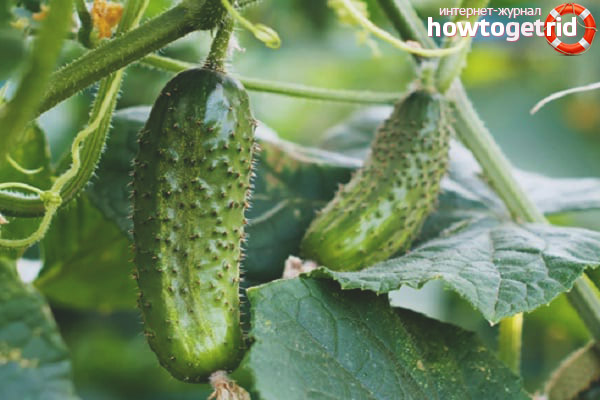The content of the article
Hybrid cucumber varieties are popular with gardeners and farmers throughout the country. Berendey earned recognition and became popular due to its unpretentiousness, persistent immunity to diseases and high productivity.
Cucumbers have an early ripening period. Vegetable crops are grown in open beds, as well as in greenhouse constructions. The shade tolerance of the plant allows you to grow a variety on the balcony. The variety tolerates minor temperature differences.
Grade description
Bushes of plants are medium-branched, the type of flowering is female. Ovaries form in bundles. This variety is characterized by a bouquet type of growth. The leaves are medium in size and dark green in color. In one node, 2 to 4 fruits are formed. Cucumbers are shaped like a cylinder. Seeds are small or absent altogether. The skin is dark green with white stripes, on the surface there are medium-sized tubercles. White spikes are noted. The fruit pulp is dense, crisp, has no voids and bitter taste.
The length of one fruit does not exceed 13 cm. The average weight of a cucumber is approximately 130 grams. Variety Berendey is quite unpretentious to the growing conditions, however, to obtain the highest possible yield, you need to follow some care rules.
Landing
Seeding for seedlings is recommended at the end of April. As soon as 4-5 leaves are formed on the sprouts, they can be transplanted into the ground. Between adjacent holes and between rows it is necessary to observe the distance, it must be at least 50 cm.
Variety Care Rules
Watering plants is recommended in the morning. Water should be warm so that the roots do not get too cold when watering. How much water is needed depends on the period of development. When tying inflorescences per square meter, you should spend 5 liters of water on dry days, and 3 liters during rainy weather. From the beginning of the formation of fruits, the need for plants to obtain water increases. During this period, up to 10 liters of warm water should be added during drought, after rains the rate is reduced to 6 liters.
Top dressing is applied only 1 time during the growing season. Preference should be given to mineral complexes, which include sulfate, magnesium and nitrogen. Great for this purpose are home-made products: diluted dry mullein, infusion of onion husks, and also when watering, experts recommend adding urea (10 grams of urea per 10 liters of water).
It is not necessary to prevent the appearance of a crust on the soil, so after watering it is recommended to carry out the hilling of the bushes. The procedure must be carried out carefully, since the root system is located close to the surface of the earth, and it can be damaged. It is desirable to cultivate the variety using the trellis method. The lashes are tied to a support, this increases productivity and facilitates care. Scourges of plants do not need to be formed.
Diseases and harmful insects

Despite the high resistance to common fungal diseases, treatment of bushes should be carried out as a preventive measure.A variety with an early ripening period cannot be processed with agents that include chemical compounds. In the fruit, toxins can thus accumulate. For this purpose, use the following solutions:
To prevent mildew infection, plants are treated with a solution of iodine and soap with the addition of milk. The prepared mixture is sprayed with foliage of bushes.
Bacteriosis can be prevented using tablets of the drug Trichopolum (2 tablets per 1 liter of water).
If you water the bushes with the addition of baking soda, this will help prevent infection and the spread of white and gray rot.
In pest control, certain procedures are suitable. In the fall, you need to dig the soil and leave it to freeze. So you can destroy the possible harmful insects. The neighborhood of cucumbers with onion and garlic plantings will also help. The most dangerous pests are spider mites and slugs. It is recommended to regularly conduct a visual inspection of the bushes. If you find affected leaves or an invasion of pests, you must immediately take the necessary measures to eliminate the problem.
Variety Berendey is a universal species. Cucumbers are great for eating fresh, for making salads, for slicing. You can preserve vegetables according to different recipes. When pickling and pickling, cucumbers do not lose their qualities. Among lovers of cucumbers, you can find only positive reviews about this variety.
Reviews gardeners
- Daria Denisovna, 56 years old: Planted cucumbers of the Berendey variety in her country house. The bushes have grown quite well. There were a lot of ovaries, there was no empty flower at all. Cucumbers grew together. Harvesting began a month and a half after the appearance of sprouts. Excellent taste of cucumbers, fruits are juicy and crispy. Prepared blanks for the winter. Plants are not whimsical to care at all. The most important thing is to water and feed on time.
- Nikita Pavlovich, 63 years old: This year I decided to plant a new variety of cucumbers in the garden. Acquired cucumbers Berendey. The result was completely satisfied. Bushes should be tied up, fed with fertilizers and watered. Such simple care rules made it possible to get a great harvest. Cucumbers are dense and crispy. He made preparations for the winter. I recommend to everyone!
Video: F1 Berendey cucumbers










Submit